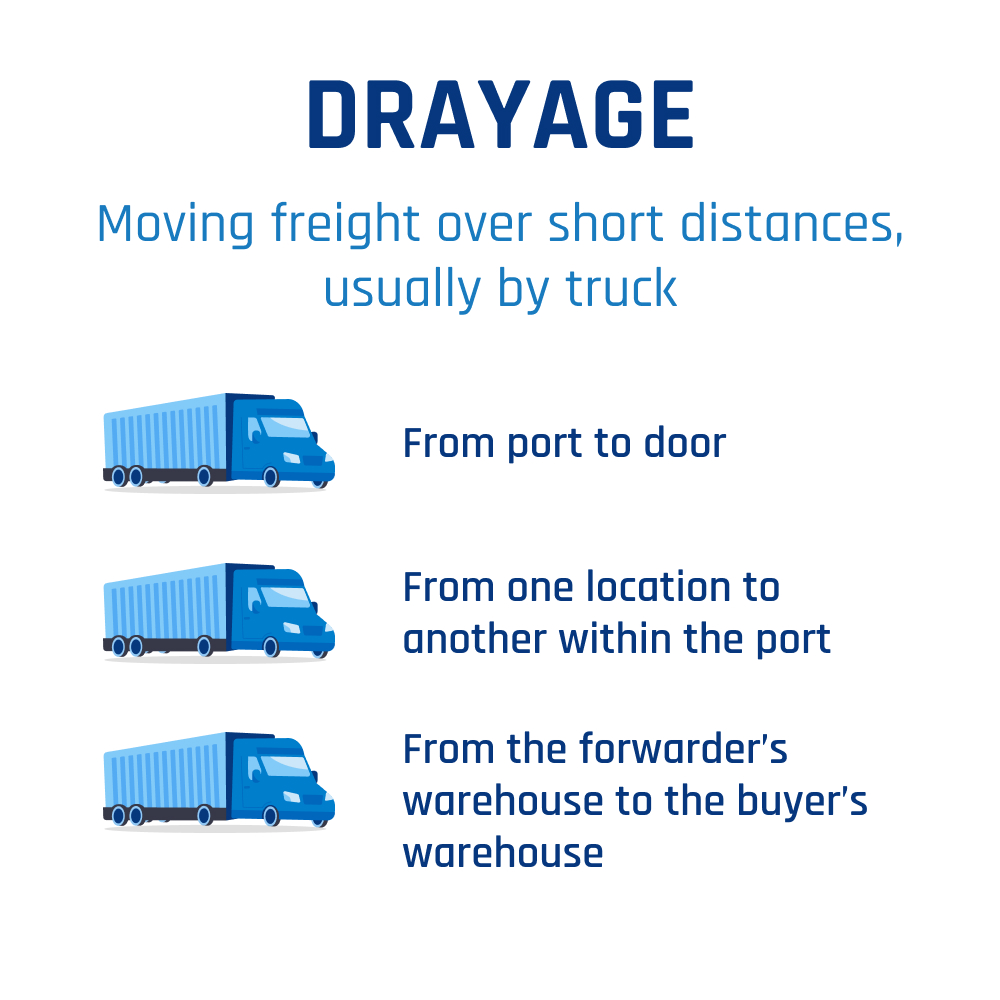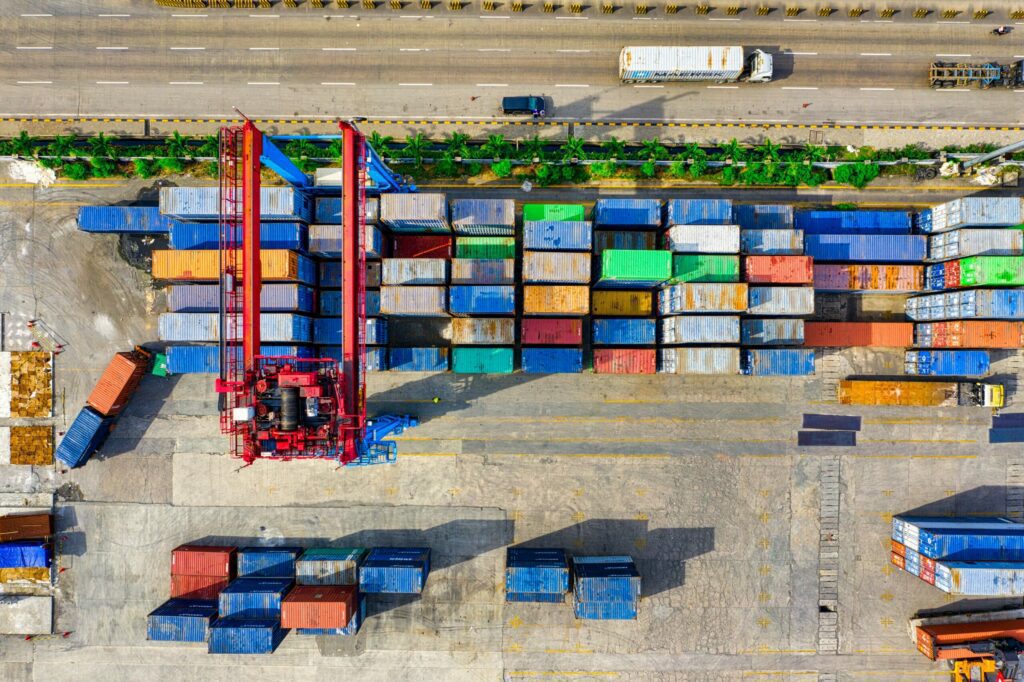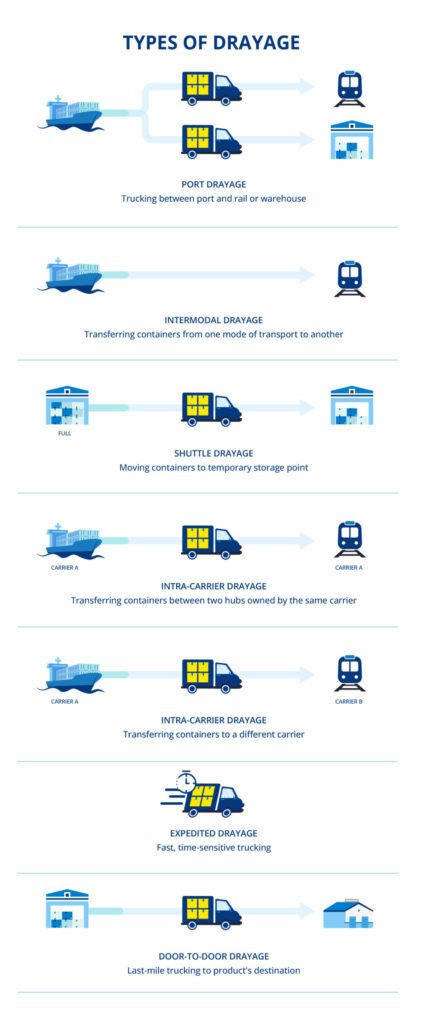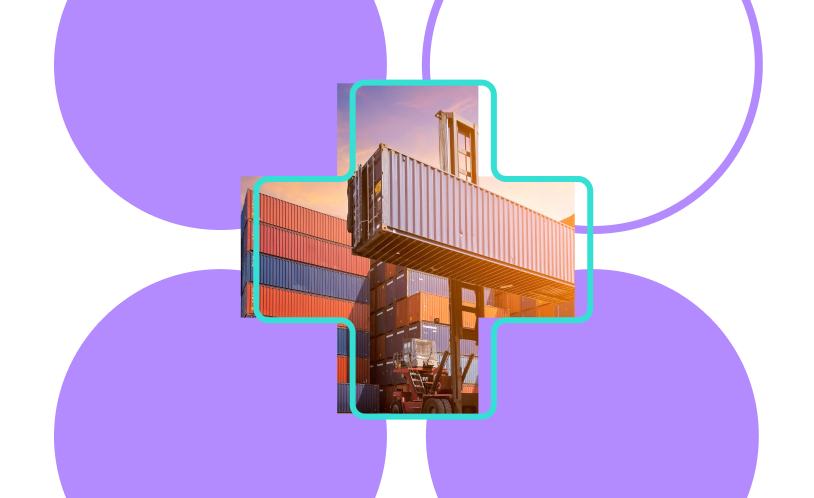Drayage is a small but important part of getting goods where they need to go.
What is drayage? What are drayage costs and how are they calculated? Read on to find out.
Drayage definition and meaning
Drayage has two meanings:
- Moving freight containers short distances between ports, warehouses, or intermodal terminals. The transfer is usually completed by truck within a day.
- The fees associated with drayage services.
If you’re shipping a container from a warehouse in China to a warehouse in New York, you’ll need drayage services twice:
- To move your container from your manufacturer or warehouse to the port of origin in China
- To move your container from the destination port to your chosen warehouse in New York

Despite the transfer usually being completed by truck, drayage is not the same as over-the-road trucking, intermodal shipping, or cartage. Here are some differences between these services:
Drayage vs. over-the-road trucking
Although both terms refer to transportation by truck, drayage means moving containers over short distances, while over-the-road (OTR) trucking involves transporting over long distances across different regions, states, or countries.
Drayage vs. intermodal shipping
Drayage is moving freight by truck only for short-haul, while intermodal shipping uses two or more modes of transport to move freight over long distances. Drayage can be a part of intermodal shipping.
Drayage vs. cartage
Both drayage and cartage involve moving goods by road. But drayage means transporting the entire container, while cartage describes breaking freight into smaller parts for transportation.
Container drayage services are provided using drayage trucks.
What is a drayage truck?
Drayage trucks are large semi-trailers and trucks used to transfer shipping containers or bulk freight between different shipping facilities. Large drayage companies own and operate drayage trucks.

What is container drayage?
Container drayage refers to short-haul container transport by truck within a radius of 15-50 miles from port.
Drayage trucks are equipped to handle different container types, including standard dry containers, high cube containers, and refrigerated containers.
Why is drayage important?
Since drayage connects different processes in logistics operations, it is an important step in the supply chain network. Here are some examples of how drayage can smooth and speed up supply chain logistics:
Facilitate intermodal container transfers
Drayage is how containers are moved from one mode of transportation to another – for example, between rail and ocean, air and rail, and so on.
Allow timely movement in cold chain shipping
For refrigerated cargo, drayage means perishable or temperature-controlled freight can be moved quickly between ports and storage facilities.
Ease container congestion at ports
Drayage trucks move containers between vessels and warehouses or between different terminals. This makes the transportation process faster, helps avoid bottlenecks, and eases port traffic.
Speed up empty container repositioning
After a shipment is delivered, carriers need to move the container on to the next shipper. This is called empty container repositioning. Drayage services move containers easily in the same vicinity.
Keep the supply chain steady
Drayage keeps the flow of containers in the supply chain uninterrupted by providing a vital link between shipping facilities.
Looking to get started shipping?
What are different drayage services?
There are a number of different types of drayage services:
Port or pier drayage – Transporting containers over short distances between ports and other facilities such as warehouses or distribution centers. For port drayage, trucks need chassis designed for hauling containers.
Intermodal Drayage – Moving containers between different modes of transport, such as rail terminals and container ships. Drayage is the only means of container transfer in intermodal shipping.
Shuttle drayage – Shifting containers to a temporary storage point for a short period. Shuttle drayage is used to keep containers safe until the next vessel is ready for departure.
Intra-carrier drayage – Transferring containers by the same carrier.
Inter-carrier drayage – Transferring containers between two different carriers.
Expedited drayage – Transportation of time-sensitive freight over short distances.
Door-to-door drayage – Delivery of a product from a transportation hub to a final destination. Also known as retail drayage, door-to-door drayage makes up the last mile of logistics.

How are drayage costs calculated?
The term drayage also refers to charges for drayage services.
Drayage fees are calculated based on the weight of the freight or container. A base fee is charged for every 100 pounds (45 kg) of weight.
If the freight weight is 123 pounds, it is rounded up to the next hundred i.e. 200 pounds. This is then multiplied by the ongoing drayage rate depending on the port and company.
For example, if your freight weighs 937 pounds and the ongoing drayage rate is $80 per unit, your total drayage cost would be calculated for 1000 pounds, i.e. [(1000 ÷ 100) x 80] = $800.

Drayage cost and fees
Drayage costs can include the following:
Line haul rate – The cost of transporting containers between two points. It is calculated based on the distance of the trip.
Ocean terminal charges – Port charges including handling, storage, and container maintenance.
Chassis usage fee or chassis split fees – The fee for using a chassis to help move goods. A chassis split fee is charged when the chassis is unavailable at the port where the container is unloaded and the trucker needs to retrieve it from another location.
Drop fees – Charged when the truck delivers a container at a warehouse and returns to pick up the empty container at a later time instead of it being emptied immediately.
Yard pull or pre-pull fees – The charge for picking up a container from a port and storing it in a warehouse before delivery. This is usually done to avoid demurrage fees, which are incurred when a container stays too long at the port.
Special handling charges – Charges for any additional handling or special equipment required for overweight, hazardous, or refrigerated freight.
How to reduce drayage cost
Drayage fees are among the lower costs in shipping, but they can add up. Planning ahead can help avoid unexpected drayage charges:
Pack goods efficiently
Package your freight efficiently to keep the overall weight low.
Pack fragile and non-fragile freight separately
Fragile loads incur special handling charges, so separate your non-fragile items to ensure they can be moved easily and economically on crates or pallets. Separate the shipments under different bills of lading to reduce shipping and drayage costs.
Ship directly to warehouses
When booking freight forwarding services, ship directly to your destination warehouse. This means planning for drayage costs up front, which is usually cheaper than adding them at the last minute.
Schedule your freight accurately
Efficient drayage depends on accurate pick-up and delivery times. Delays may lead to additional costs such as truck waiting time or demurrage and detention charges.
Leave a buffer
When calculating drayage fees, account for unexpected shipping delays, customs inspection, or other sudden events.
Looking ahead
The drayage service market is expected to increase by almost three billion dollars between 2021 and 2025. With more production, increased shipping demands, and growing eCommerce, drayage is more important than ever in global logistics operations.



